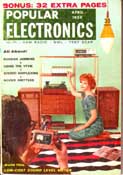CBS Stereo Simplex
CBS Stereo Simplex
(thumbnail links corrected)
Fellow Radiophiles:
In the early days of stereo, clever techniques were used to get as much power as possible from just two tubes. These techniques typically involved ampifying efficient combinations of L+R and L-R signals to get separate L and R signals driving the L and R speakers.
Generally speaking there is much more power to be delivered by the L+R signal than by the L-R signal. Usually all bass content is in the L+R signal.
This prompted a trick where L+R signals are amplified by a pair of pentodes in Push-Pull, while the much weaker L-R signal is amplified by the same tubes in single ended drive. This trick was used by several manufacturers.
One specific example is in the Emud 910 stereo Console in Europe.
CBS in the USA also used this design. The following two articles by Harry Kolbe appeared in the April 1959 issue pp45-50 of Popular Electronics, and explain the operation of the CBS version, called the Stereo Simplex:
A slightly different technique was also used extensively by Motorola in the early 1960's and in at least one set by Grundig.
This technique also amplifies the bass signal in push-pull, but the bass is output in as a third mono channel.
The left and right signals are amplified singled ended but only for midrange and treble. The L and R speakers take their midrange+treble signal from small single ended transformers.
The simplest versions of this approach derive the phase opposing L and -R signals by reversing one connection to the stereo ceramic or crystal cartridge. Having one channel inverted is perfect for push-pull drive of the center-tapped bass transformer.
For a further exploration of this topic go to Grundig 3 Channel Stereo.
This approach to stereo from the early 1960's is probably the forerunner of today's 3 and 5 channel stereo systems, that employ a mono subwoofer and 2 or more pairs of midrange+trebble satelite speakers.
Regards,
-Joe
p.s.:The quality of the scans posted above is poor. I will try to relocate this magazine, rescan it and upload cleaner copy.
March 10th 2010 New high quality scans uploaded to thumbnails
To thank the Author because you find the post helpful or well done.
Fresh Scans
Greatly improved scans have replaced the original scans in the thumbnails above.
These two samples show the quality at 100% zoom:

Just the click the thumbnails in post#1 above to see or save the new scans.
Regards,
-Joe
To thank the Author because you find the post helpful or well done.
One bad link
The picture URL for the 4th thumbnail is still bad. I tried correcting it but it did not work.
-Joe
To thank the Author because you find the post helpful or well done.
The links was working very well ...

... but the result of printing an article with thumbnails is really a mess.
I've sent you a PDF with all the big pictures included, but the file size of 700kB is off the limits of standard attachments.
That is the reason why OCR is the "state-of-the-art" method to offer texts of that qualitiy, as to be seen at the german "Funkschau" project.
If the "Funkschau" would have been issued as "included thumbnails" it would not worth to use disc space on the RMorg server.
Best Regards,
GR
To thank the Author because you find the post helpful or well done.








